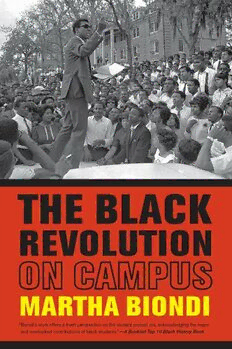
The Black Revolution on Campus PDF
Preview The Black Revolution on Campus
The Black Revolution on Campus Martha Biondi university of california press Berkeley • Los Angeles • London The Black Revolution on Campus This page intentionally left blank The Black Revolution on Campus Martha Biondi university of california press Berkeley • Los Angeles • London University of California Press, one of the most distinguished university presses in the United States, enriches lives around the world by advancing scholarship in the humanities, social sciences, and natural sciences. Its activities are supported by the UC Press Foundation and by philanthropic contributions from individuals and institutions. For more informa- tion, visit www .ucpress. edu . University of California Press Berkeley and Los Angeles, California University of California Press, Ltd. London, En gland © 2012 by Martha Biondi Library of Congress Cataloging-i n-P ublication Data Biondi, Martha. The Black revolution on campus / Martha Biondi. p. cm. Includes bibliographical references and index. isbn 978-0 - 520-2 6922- 4 (cloth : alk. paper) 1. African American student movements. 2. African American college students—P olitical activity— History—20th century. 3. African Americans—E ducation (Higher)—H istory. I. Title. LC2781.B38 2012 378.1'982996073—dc23 2012001211 Manufactured in the United States of America 20 19 18 17 16 15 14 13 12 10 9 8 7 6 5 4 3 2 1 In keeping with a commitment to support environmen- tally responsible and sustainable printing practices, UC Press has printed this book on Rolland Enviro100, a 100 percent postconsumer fi ber paper that is FSC certifi ed, deinked, pro cessed chlorine-f ree, and manufactured with renewable biogas energy. It is acid- free and EcoLogo certifi ed. Contents List of Illustrations vii Introduction. The Black Revolution on Campus 1 1. Moving toward Blackness: The Rise of Black Power on Campus 13 2. A Revolution Is Beginning: The Strike at San Francisco State 43 3. A Turbulent Era of Transition: Black Students and a New Chicago 79 4. Brooklyn College Belongs to Us: The Transformation of Higher Education in New York City 114 5. Toward a Black University: Radicalism, Repression, and Reform at Historically Black Colleges 142 6. The Counterrevolution on Campus: Why Was Black Studies So Controversial? 174 7. The Black Revolution Off-C ampus 211 8. What Happened to Black Studies? 241 Conclusion. R efl ections on the Movement and Its Legacy 268 Notes 279 Selected Bibliography 319 Ac know ledg ments 325 Photo Credits 329 Index 331 This page intentionally left blank Illustrations Figure 1. Po liti cal scientist Charles Hamilton / 21 Figure 2. In March 1968, students at Howard University occupied the administration building / 38 Figure 3. Sociologist Nathan Hare / 50 Figure 4. Strike leaders address a rally / 61 Figure 5. Strike leaders at the head of a mass march of ten thousand students on campus during “December days” / 63 Figure 6. Tactical squad police brutally beat and arrested Don McAllister / 64 Figure 7. Students in front of the Northwestern building that housed the bursar’s offi ce / 86 Figure 8. Northwestern student Eva Jefferson (later Eva Jefferson Paterson) at a Chicago rally / 88 Figure 9. White student sympathizers show support / 90 Figure 10. Graduate student James Turner explains the goals for the sit-i n to the media / 91 Figure 11. Lerone Bennett / 96 Figure 12. Historian Sterling Stuckey / 99 Figure 13. Charles Hurst, president of Malcolm X College, with Jesse L. Jackson and Betty Shabazz / 110 vii viii | Illustrations Figure 14. “Support the Five Demands” was the rallying cry for students at City College of New York in 1969 / 130 Figure 15. T he admissions policy at City College quickly changed the demographics / 136 Figure 16. Stokely Carmichael, a leader of the Student Non-V iolent Coordinating Committee / 147 Figure 17. Lerone Bennett and Ewart Guinier / 194 Figure 18. Legendary Harlem historian John Henrik Clarke / 212 Figure 19. V incent Harding and St. Clair Drake, 1971 / 229 Figure 20. W illiam Strickland and Walter Rodney / 230 Introduction The Black Revolution on Campus “Black young people feel they can change society,” a minister in San Francisco observed in 1969. “Now that’s very important.” Black stu- dents want “revolutionary change in the basic institutions in this coun- try,” echoed a young politician. According to students in San Diego, “Racism runs rampant in the educational system, while America, in a pseudohumanitarian stance, proudly proclaims that it is the key to equal opportunity for all.” “This is the hypocrisy,” they declared, that “our generation must now destroy.”1 This widespread feeling of power and purpose among Black college students, combined with a sense of ur- gency and context of crisis, produced an extraordinary chapter in the modern Black freedom struggle. Black students org a nized protests on nearly two hundred college campuses across the United States in 1968 and 1969, and continued to a lesser extent into the early 1970s. This dramatic explosion of militant activism set in motion a period of con- fl ict, crackdown, negotiation, and reform that profoundly transformed college life. At stake was the very mission of higher education. Who should be permitted entry into universities and colleges? What consti- tuted merit? Who should be the future leaders of the nation in this postsegregation era, and how should this group be determined? What should be taught and who should teach it? Perhaps most controver- sially, should students have a hand in faculty selection or governance? Moreover, what would happen to public Black colleges in this era of 1
